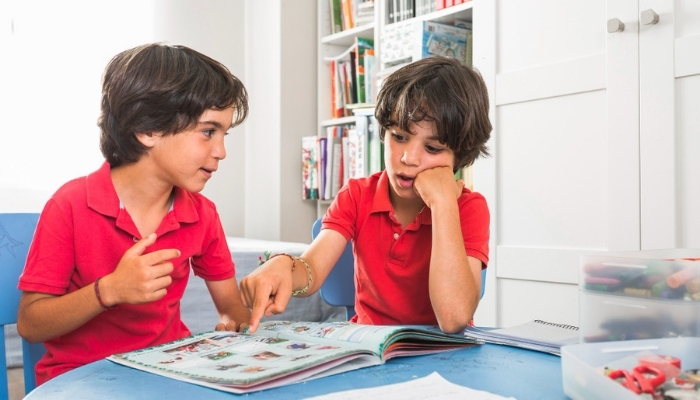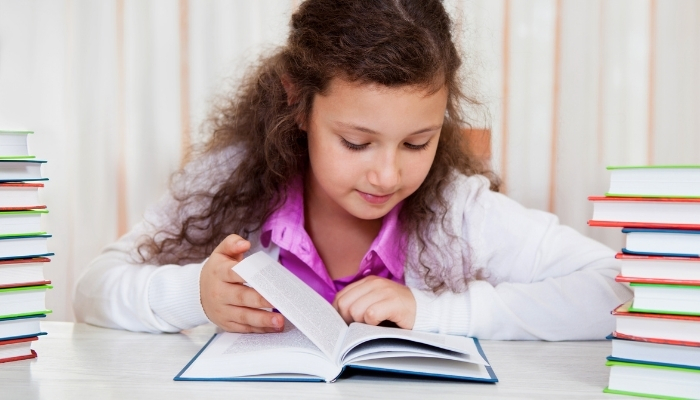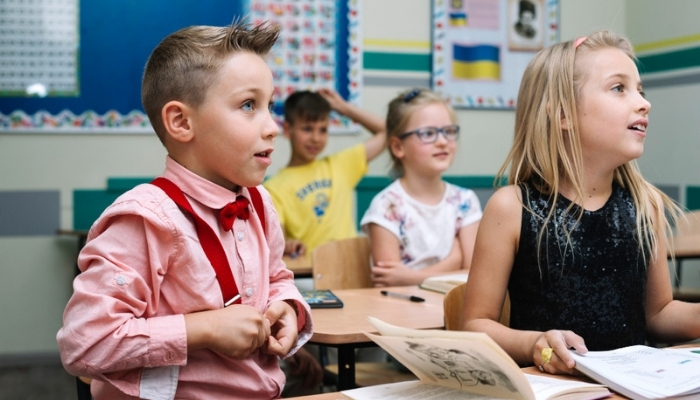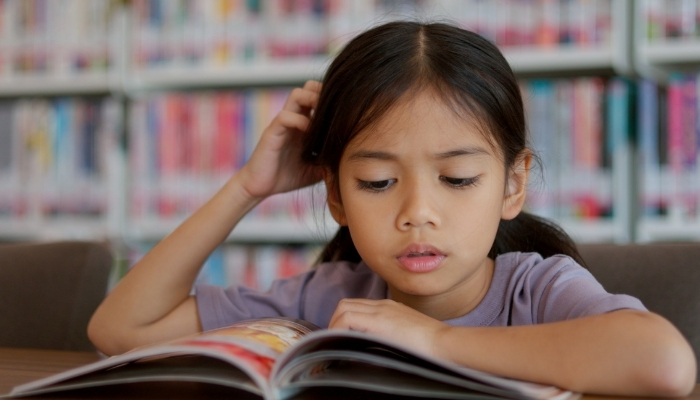You notice your kindergartener picking up the “Milk” carton from the fridge and excitedly saying the word aloud, or spotting the word “STOP” on a street sign during a walk. It’s the moment they begin connecting letters to sounds and realizing that the words represent real things in their world. Moments like these show that your child is starting to read, but how do you know if they’re on track?
Your answer lies in knowing the exact kindergarten reading goals they should achieve. These goals define the specific skills your child should develop by the end of the year, such as letter recognition, phonics, sight word recognition, and early comprehension. By understanding these benchmarks, you can see where your child is excelling and where they may need support.
This guide breaks down what to expect from your little one, practical ways to support them, and understand where and how you can intervene to boost their learning growth.
Key Takeaways
-
Kindergarten reading goals build the foundation for confident, independent readers.
-
Early practice in letter recognition, phonics, and comprehension lays a strong foundation for future learning across subjects.
-
Daily reading interactions and meaningful conversations accelerate vocabulary and critical thinking development.
-
Structured support, like small-group lessons and interactive activities, enhances skill mastery and reading confidence.
-
Combining home reading routines with targeted programs helps children develop a lasting love for books.
The Importance of Reading Goals in Kindergarten

Kindergarten reading goals provide a clear roadmap for your child's early reading development. They help track progress and ensure children are building the right skills to become confident readers by the end of the year.
At this stage, kids start noticing that the letters and words on a page actually mean something. They begin connecting letters to sounds, spotting familiar words, and following simple story patterns. These early skills set the stage for smoother reading later on.
Multiple studies also show that children who meet these reading goals in kindergarten often find later schoolwork easier to manage. They understand stories better, pick up new words faster, and feel more confident in class. Focusing on these goals provides parents and teachers with a clear roadmap for supporting them.
Key Kindergarten Reading Goals
Kindergarten reading goals define the essential skills children typically develop during their first year of formal reading instruction. Understanding these goals helps you support your child’s learning journey with confidence.
Below are the important skills these goals cover:
Understanding Print and How Books Work
Print awareness helps your child understand the basic mechanics of reading and books. This foundational skill may seem simple, but it represents a significant cognitive leap for young learners.
By the end of kindergarten, most children are familiar with the parts of a book and their functions, and begin to track print when listening to familiar text being read. Your child will understand that we read from left to right and top to bottom in the English language.
They'll learn that spaces separate words and that sentences start with capital letters. Your kindergartener will also discover that the words they hear have matching printed words on the page.
Some children master these concepts quickly, while others need repeated exposure throughout the year. Both timelines are perfectly normal for kindergarten development.
Developing Phonemic Awareness and Phonics
Phonemic awareness refers to the ability to recognize that spoken words are composed of individual sounds. This skill forms the bridge between hearing language and reading it on paper.
Most kindergarteners learn to identify beginning sounds in words and begin recognizing some ending sounds as well. Children typically demonstrate understanding that spoken words consist of sequences of phonemes and can identify rhyming words.
Your child will begin connecting letters to their most common sounds, especially for consonants like "b," "m," and "s." Many kindergartners also learn short vowel sounds, although this skill often continues to develop into first grade.
Don't worry if your child mixes up similar-looking letters, such as "b" and "d." This is extremely common and usually resolves with time and practice.
Recognizing High-Frequency Words
High-frequency words are the most common words in children's books and everyday writing. Learning to recognize these words instantly helps beginning readers gain confidence and fluency.
Most kindergarteners recognize some words by sight, including prevalent ones like "a," "the," "I," "my," "you," "is," and "are." Your child might recognize 10-25 sight words by the end of kindergarten, though this number varies significantly among children.
Some kindergarteners learn many more sight words, while others focus on mastering just a few. Both approaches support reading development when children receive appropriate instruction and encouragement.
Building Vocabulary Through Reading and Conversation

Vocabulary growth happens naturally through rich conversations and exposure to diverse books. Your child learns new words by hearing them used in meaningful contexts during daily activities.
Kindergarteners typically expand their speaking vocabulary from about 5,000 to 8,000 words during the school year. Children use new vocabulary and grammatical constructions in their own speech and make appropriate switches from oral to written language situations.
Your child will start asking more questions about unfamiliar words and begin using descriptive language to express their thoughts and feelings more effectively. They might also start noticing when sentences don't make sense.
Additionally, it's essential to note that children who speak multiple languages may take longer to develop their English vocabulary.
Strengthening Reading Comprehension
Comprehension means understanding stories and information, not just reading words correctly. This skill develops gradually as children gain more experience with books and storytelling.
Most kindergarteners can retell, reenact, or dramatize stories or parts of stories, and correctly answer questions about stories read aloud to them. Your child will learn to make predictions based on pictures and the events in a story.
They'll start connecting story events to their own experiences and expressing simple opinions about characters. Many kindergarteners also begin identifying main characters and basic story settings.
Also Read: Reading Comprehension Games and Activities for Students
Developing Fluency and Expression
Reading fluency involves reading smoothly with appropriate speed and natural expression. This skill develops slowly throughout kindergarten and beyond as children become more confident with letters and words.
Many kindergarteners read familiar books with increasing smoothness, though they may still pause frequently to sound out words. Children begin to track print when listening to familiar texts and can "read" familiar texts emergently.
Your child might also start using punctuation marks to guide their expression, raising their voice at question marks or pausing at periods. However, truly fluent reading typically develops in first and second grade.
Also Read: Engaging Reading Fluency Games for Students
Building Reading Stamina and Habits
Reading stamina refers to your child's ability to focus on books for extended periods. This endurance grows throughout the kindergarten year as children develop stronger attention spans.
By the end of kindergarten, your kid can listen attentively to books that teachers read to the class, and can name some book titles and authors. Your child will gradually increase their independent book browsing time from just a few minutes to 10-15 minutes.
They will also develop preferences for certain types of books and may ask to hear their favorite stories multiple times. This repetition actually supports their reading development, so embrace those requests for the same book again and again.
Writing and Letter Formation
Writing skills develop alongside reading abilities and support each other throughout kindergarten. Many children initially find writing more challenging than reading, and that's completely normal.
Kindergarten students can independently write many uppercase and lowercase letters and write their own name (first and last). They begin using their letter knowledge to spell words creatively, a technique often referred to as "invented spelling."
Your child might write "KAT" for "cat" or "LUV" for "love" - these attempts show they're applying their phonics knowledge creatively. This developmental spelling is actually a positive sign of reading progress.
These foundational skills work together to prepare your child for the more complex reading challenges they will face in first grade. Remember that children develop at different rates, and some skills may emerge earlier or later than others.
Also Read: Fun Ways to Teach Writing Letters That Make Learning Enjoyable
How to Tell if Your Child Could Benefit from Extra Guidance?

Every child learns to read at their own pace, and recognizing when your child might benefit from additional support shows your commitment to their success. Many perfectly capable children simply need more time and practice to master specific reading skills.
You're not looking for problems; you're being a thoughtful parent who wants to help your child succeed. In fact, about 15% of children experience learning difficulties, which means noticing when your child could benefit from extra guidance is common and completely normal.
Let's look at some signs that commonly occur:
-
Letter Recognition Struggles: Your child has difficulty naming more than half of the alphabet letters after several months of kindergarten.
-
Limited Sound Awareness: They struggle to identify beginning sounds in simple words, or can't think of rhyming words.
-
Sight Word Challenges: Your kindergartener recognizes fewer than 5-10 high-frequency words by mid-year.
-
Comprehension Difficulties: They struggle to answer basic questions about familiar stories or appear confused during read-alouds.
-
Avoidance Behaviors: Your child consistently resists reading activities or becomes frustrated when looking at books.
You might also notice that your child has trouble following along during story time or seems overwhelmed by books that other kindergarteners enjoy. This can feel frustrating, but it’s important to remember that every child learns at their own pace. If your child continues to struggle despite your efforts, seeking additional support can make a real difference. There are programs designed to provide focused, systematic help to build essential reading skills.
For example, you can try FunFox Readers Club, which offers small-group instruction where children practice letter recognition, phonics, and comprehension with personalized attention, helping them gain confidence while keeping learning enjoyable and engaging.
Tips for Supporting Kindergarten Reading Growth

You play a crucial role in your child's reading development, and the good news is that the most effective support occurs through simple, daily interactions. Consistency matters more than perfection, so choose activities that work for your family's schedule and stick with them.
Here are research-backed strategies that help kindergarteners develop strong reading skills:
Create Enjoyable Reading Routines
-
Read aloud to your child every day, even if it's just for 10 minutes before bed.
-
Let your child choose books that interest them, including their favorite titles.
-
Make reading interactive by asking simple questions, such as "What do you think will happen next?"
-
Point to words occasionally as you read to help your child connect spoken and written language.
Support Letter and Sound Learning Naturally
-
Practice letter names during everyday activities, like pointing out letters on signs while driving.
-
Play simple rhyming games with your child's name or favorite words.
-
Help your child write their name and simple words using magnetic letters or paper.
-
Celebrate every attempt at letter writing, even if the letters aren't perfectly formed.
Build Vocabulary Through Rich Conversations
-
Talk with your child throughout the day about what you're doing, seeing, and thinking.
-
Ask open-ended questions that encourage your child to use descriptive words.
-
Introduce new words during cooking, shopping, or outdoor activities.
-
Listen actively to your child's ideas and respond with genuine interest.
Make Your Home Print-Rich
-
Keep books accessible in different rooms and rotate them regularly to maintain interest.
-
Display your child's writing attempts proudly to encourage continued efforts.
-
Visit the library regularly and let your child choose books to check out.
-
Point out printed materials in everyday situations, such as grocery lists, street signs, and food labels.
Support Writing Development
-
Provide opportunities for your child to write or draw about their experiences.
-
Accept creative spelling attempts as signs of growing phonics knowledge.
-
Help your child write thank-you notes, grocery lists, or letters to family members.
-
Show excitement about your child's writing efforts, focusing on their ideas rather than perfect spelling.
Work with Your Child's Teacher
-
Ask your child's teacher about specific skills to practice at home.
-
Share observations about your child's reading interests and challenges.
-
Attend parent-teacher conferences and school reading events when possible.
-
Follow through on teacher suggestions while keeping activities fun and pressure-free.
Ensure a positive attitude towards reading, as it has a profound impact on your child's feelings about books and learning. When you show genuine enthusiasm for telling stories and conducting reading sessions, your child is more likely to develop similar feelings.
Final Words!
Kindergarten reading goals are the first building blocks of your child’s lifelong learning journey. Every new word they recognize and every story they understand strengthens their confidence and curiosity. Some children may require additional support to develop these skills, which is entirely normal.
FunFox Readers Club provides practical ways to reinforce these skills while keeping reading enjoyable:
-
Small-group online lessons (3–6 students) for personalized attention.
-
Focused practice on phonics, fluency, and comprehension.
-
Interactive games and hands-on activities to make learning engaging.
-
Process-based feedback tailored to each child’s progress.
-
Access to digital worksheets and curated reading materials for home practice.
Take the first step towards helping your child meet their kindergarten reading goals while building a love for books. Enroll in FunFox Readers Club today and make reading an exciting adventure.
FAQ’s
1. What reading level should a kindergartener be at?
Kindergarteners typically recognize letters, know basic phonics, and read simple sight words. They can follow short sentences, understand familiar stories, and demonstrate emerging comprehension through retelling or answering questions.
2. What should a kindergartener be able to read?
They should read simple books with repetitive patterns, high-frequency words, and short sentences. Children can identify letters and sounds, recognize some words by sight, and follow basic storylines.
3. What is level C reading in kindergarten?
Level C indicates early readers can read simple three-sentence books independently, recognize basic sight words, and retell key events using pictures and familiar words.
4. How much should a child be able to read before kindergarten?
Before kindergarten, children typically recognize most letters, understand the sounds of letters, identify some high-frequency words, and demonstrate curiosity about books through listening, pointing, and attempting to read aloud.















